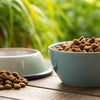What is the Difference Between Wet and Dry Dog Food?
- Houndsy
Table of Contents
- Introduction
- Understanding the Basics: What Constitutes Wet and Dry Dog Food?
- Nutritional Content: Wet vs. Dry Dog Food
- Pros and Cons of Wet Dog Food
- Exploring Dry Dog Food: Pros and Cons
- The Great Debate: Which One Is Better for Your Dog?
- Feeding Your Dog: Tips and Best Practices
- Our Commitment to Pet Feeding Solutions
- Conclusion
Introduction
Have you ever stood in an aisle filled with vibrant bags and cans, each promising the best for your furry friend, and thought, “What should I choose?” You’re not alone. According to surveys, up to 50% of dog owners feel uncertain about the best feeding options for their pets. This choice often centers between wet and dry dog food, an essential decision impacting your dog's overall health and dining experience.
At Houndsy, we understand that selecting the right dog food is just as important as maintaining a stylish feeding area that complements your home. Given our mission to simplify and elevate the everyday feeding experience, exploring the differences between wet and dry dog food is crucial—both for convenience and aesthetics.
In this comprehensive blog post, we’ll delve deep into the distinctions between wet and dry dog food, discussing everything from processing methods and nutrient content to benefits and drawbacks of each. Through our exploration, we hope to empower you, the dog owner, to make informed choices that enhance your pet's life while promoting a space that reflects your values.
By the end, not only will you clearly understand what is the difference between wet and dry dog food, but you'll also discover how our Houndsy Kibble Dispenser can facilitate this feeding process with style and ease.
Understanding the Basics: What Constitutes Wet and Dry Dog Food?
Before we dive deeper into the advantages and disadvantages of wet and dry dog food, it’s essential to establish a clear understanding of each type.
Wet Dog Food
Wet dog food is often recognized for its higher moisture content, ranging from 70% to 84%. Typically served in cans or pouches, this food consists of meat chunks, gravy, or jelly, making it particularly appealing to many dogs. Its approach to processing involves grinding protein sources and combining them with grains, vitamins, and minerals before being cooked and sterilized to result in a canned product.
Some key characteristics of wet dog food include:
- Moisture: With its high water content, wet food contributes significantly to your dog's hydration, particularly beneficial for pets that are less inclined to drink sufficient water.
- Palatability: Most dogs find wet food more flavorful, making it a great option for picky eaters or those recovering from illness.
- Texture Variety: The soft, meaty texture of wet food offers sensory stimulation during meal times.
Dry Dog Food
In contrast, dry dog food (often referred to as kibble) usually contains around 12% moisture or less and is characterized by its crunchy texture. The production of dry dog food involves pulverizing protein sources to create dough, which is then cooked, extruded into specific shapes, dried, and coated with fats, vitamins, and minerals.
Key attributes of dry dog food include:
- Convenience: Easy to store, measure, and serve, dry food is less messy compared to its wet counterpart.
- Shelf Stability: Kibble retains its freshness longer, making it a practical choice for busy pet owners.
- Dental Health: The chewing action required for kibble can aid in dental health by reducing plaque buildup.
Nutritional Content: Wet vs. Dry Dog Food
Both wet and dry dog food can provide complete and balanced nutrition; however, their nutritional profiles can differ slightly.
Protein Content
Wet dog food often delivers higher protein quantities since it primarily comprises meat ingredients. This richness in protein can make wet food particularly beneficial for active dogs requiring additional muscle support.
Carbohydrates and Fiber
Dry dog food typically contains higher carbohydrate and fiber levels, providing energy and promoting digestive health. The inclusion of whole grains and vegetables offers the necessary fiber that can assist with proper digestion and enhance satiety.
Additional Nutrients
Both wet and dry dog foods are designed to meet the nutritional standards set by governing bodies, ensuring essential nutrients such as vitamins, minerals, omega fatty acids, and antioxidants. Hence, while each type has distinct advantages, feeding your dog a high-quality product, regardless of the format, is critical.
Special Dietary Needs
Considering specific dietary requirements is also essential. For instance, senior dogs or those with dental issues may thrive better on wet food due to its texture. Conversely, more active dogs might benefit from the sustained energy offered by the crunch of dry kibble.
Pros and Cons of Wet Dog Food
With a clearer understanding of what wet dog food is, let's explore its pros and cons.
Benefits of Wet Dog Food
- Hydration: Perfect for dogs that might not drink enough, helping maintain their urinary tract and kidney health.
- Flavor and Appeal: More enticing for finicky eaters or older dogs, encouraging proper nutrition.
- Easier Chewing: Beneficial for dogs with dental problems, making meals more accessible.
- Satiety: Wet dog food provides a sense of fullness, which can aid in weight management.
Drawbacks of Wet Dog Food
- Messy Situation: The higher moisture content can lead to messier feeding areas—cleaning may involve more effort post-meal.
- Shelf Life: Once opened, wet food must be promptly consumed, presenting challenges during storage.
- Cost Consideration: Generally, wet foods are more expensive than their dry counterparts due to production and packaging costs.
Exploring Dry Dog Food: Pros and Cons
Now that we have examined wet dog food, let's dive into the advantages and disadvantages of dry kibble.
Benefits of Dry Dog Food
- Affordability: Often more economical over time, providing considerable value for pet owners.
- Dental Health Benefits: Encourages chewing, which may help prevent tartar buildup.
- Convenient Storage: The longer shelf life makes dry kibble easier to manage without requiring refrigeration.
- Portion Control: Easy to measure, allowing for precise serving sizes.
Drawbacks of Dry Dog Food
- Lower Moisture Content: Not ideal for dogs that need better hydration or have difficulty drinking water.
- Less Appealing for Picky Eaters: The lack of aroma compared to wet food may lead to less enthusiasm during feedings.
- Potential for Preservatives: Many dry foods can contain artificial additives or preservatives, which some pet owners prefer to avoid.
The Great Debate: Which One Is Better for Your Dog?
So, which type of dog food reigns supreme? Ultimately, the decision hinges on your dog's specific needs, preferences, and your lifestyle as a pet owner.
Special Considerations
- Puppies: As they transition to solid food, soft, wet formulas may ease the process.
- Active Dogs: Dry food might support energy levels better during high-intensity days.
- Senior Dogs: If your older dog struggles with dental issues or has heightened hydration needs, wet food could be the optimal choice.
Is a Mix of Wet and Dry Food a Solution?
Many dog owners find success in mixing wet and dry dog food, benefiting from the texture diversity, nutritional advantages, and hydration levels. If you’re considering this option, just remember to balance caloric intake to prevent overfeeding.
Feeding Your Dog: Tips and Best Practices
Regardless of the type of food you choose, certain best practices can enhance your dog's feeding experience.
- Consult Your Veterinarian: Working with your vet ensures that your dog receives a nutritionally suitable diet.
- Rotate Brands: Occasionally switching brands can help expose your dog to diversified nutrients.
- Measure Portions: Be consistent with serving sizes to maintain an ideal weight.
- Incorporate Treats Mindfully: Remember that treats count toward daily caloric intake.
- Utilize Functional Feeding Solutions: Here at Houndsy, our Kibble Dispenser offers easy, mess-free portion control.
Our Commitment to Pet Feeding Solutions
At Houndsy, we understand the importance of creating a feeding experience that aligns with your lifestyle. Our flagship product, the Houndsy Kibble Dispenser, embodies our dedication to convenience and design excellence. With elegant, mid-century modern aesthetics, it seamlessly integrates into your home while ensuring your dog receives perfectly portioned meals every time.
Why Choose the Houndsy Kibble Dispenser?
- Convenient Crank Mechanism: Designed for standing height, eliminating the need to bend over.
- Auto-locking Feature: Prevents accidental dispensing, a relief for curious pets.
- Stylish Design: Complements modern home decor while enhancing your pet-feeding ritual.
Experience the difference with the Houndsy Kibble Dispenser and enjoy hassle-free feeding!
Conclusion
As we’ve navigated through the essential components that distinguish wet and dry dog food, it becomes evident that both formats contribute positively to your pet's diet. Ultimately, the decision hinges on your dog's unique needs and your personal preferences as a pet parent.
Whether you opt for the moist allure of canned food, the convenience of kibble, or a blend of both, our commitment remains steadfast: easing the dog-feeding experience and enhancing the daily rituals that make a house a home.
Have you thought about how your choice of food influences mealtime? Consider how incorporating our Houndsy Kibble Dispenser might not only streamline your feeding schedule but also add a touch of elegance to your pet's nutrition routine.
FAQ
Q: Can I mix wet and dry dog food?
A: Absolutely! Many pet owners find success in providing a mix for varied textures and flavors. Just be sure to adjust the portions accordingly to avoid overfeeding.
Q: Which is healthier, wet or dry dog food?
A: Both can be healthy options if they meet the nutritional needs of your dog. Always choose high-quality brands that fit your dog's specific health requirements.
Q: Is it okay to switch my dog's food type frequently?
A: Transitioning between types should be done gradually over several days to avoid digestive upset.
Q: How do I know what quantity to feed my dog?
A: Your veterinarian can provide tailored recommendations based on your dog’s age, weight, and activity level.
Join us on this journey to elevate your pet's feeding experience, and remember to explore our Houndsy Kibble Dispenser for convenient, stylish feeding solutions!












